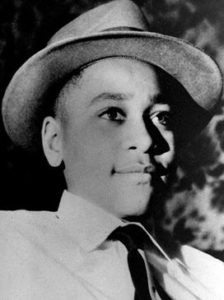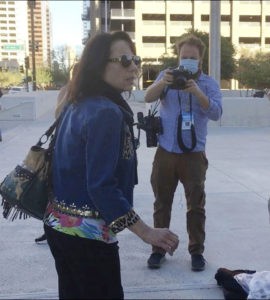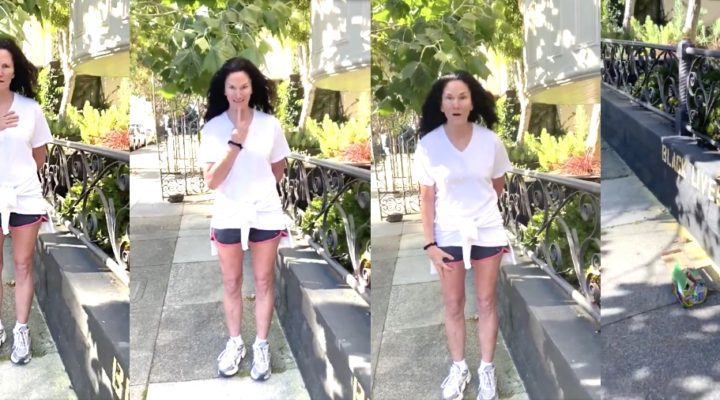The term “white supremacist” tends to elicit a stereotypical image of a raging, gun-toting, Confederate-flag-waving white man. The image is fueled by recent acts of extremism like the Unite the Right rally in Charlottesville, Va., four years ago or the insurrection at the United States Capitol in January.
Yes, both these events display disgusting spectacles of white supremacy. But the danger of emphasizing this archetype is that white supremacy becomes labeled as the movement of isolated extremists rather than a dangerously entangled social system.
Equating white supremacists with violent rioters threatens to excuse pervasive forms of racism enacted by everyday people. And constantly pointing to men as perpetrators of racism ignores the way white women participate in white supremacy.
While white women might not fit our archetype of a white supremacist, their historic and current roles in racism deserves a critical second look.
“While white women might not fit our archetype of a white supremacist, their historic and current roles in racism deserves a critical second look.”
White women bought and sold enslaved people. This challenges the idea of a meek white woman whose role in slavery was passive at best. Lacking any other type of authority, women’s active participation in slavery was a way of gaining political, social and economic power, as documented by Stephanie Jones-Rogers in They Were Her Property.
Black men as a threat to virtuous white women
In a scramble to retain power after the Civil War, white women participated in the Ku Klux Klan and created the Women of the Ku Klux Klan. The KKK aims to exclude Black Americans and immigrants from colonized spaces such as schools, churches and white families. There’s a strong belief among members that the virtue of white women is threatened by the existence of Black men.

Emmett Till
This myth manifested itself in false claims of sexual assault and led to the lynching and murder of scores of Black men. Such was the story of Emmett Till, who was lynched after being falsely accused of flirting with Carolyn Bryant, a white woman. His murder ignited the Civil Rights Movement.
It is important to note that many women as well as men and children are sexually assaulted every day. Their stories are rarely believed, and the perpetrator rarely faces any semblance of justice. This is a serious problem. But it is a different one than the problem of systemic harm committed against people of color for the sake of a thinly veiled patriarchal lie of protecting white women.
In truth, history tells us white men were the perpetrators of sexual violence against enslaved women and Black women. But the false claims of sexual assault against white women solidified the archetype of a white woman as a damsel in distress whose sexual virtue, and therefore value, needed to be protected and kept pure at all costs. The outcome created the social myth that white women are victims and Black men are perpetrators — a narrative that persists today.
And now, the ‘Karen’ archetype
White women keep the myth of victimhood alive today in part through the “Karen” archetype. The nickname Karen went viral last year through videos and memes of white, typically middle-aged women who made demands based on privilege. Many of them harassed people of color for participating in everyday activities such as being in public spaces.
“They weaponized their socially perceived image as damsels in distress in a time when rampant police brutality is threatening the lives of Black men.”
Some of these women called the police when they saw a person of color doing a mundane activity. They weaponized their socially perceived image as damsels in distress in a time when rampant police brutality is threatening the lives of Black men.
Lisa Alexander, better known as “San Francisco Karen,” called the police after seeing James Juanillo writing “Black Lives Matter” in chalk in front of his own home. A video of the encounter shows Alexander smiling throughout the conversation as she tells Juanillo to stop defacing personal property, assuming the house did not belong to him.
Other women are less often captured on camera because the lens is more focused on their flashy, fanatic male counterparts. Although they might not be the most visible or most vocal members of riots like that at the Capitol, white women were present and fueled behind-the-scenes recruitment.
The most popular photographs from Jan. 6 show a mob of men with MAGA hats and American flags or show individuals like the man in the horned, fur hat who was dubbed the “QAnon Shaman.” But women are lurking in the background of many of these photographs. Sisters, mothers and wives stood alongside their men in the riot.
Women’s participation in fringe groups helps normalize otherwise extremist movements. White women tend to practice white supremacy a little differently, exchanging the horned hat for lipstick and violence for niceness.

Martha Chansley, the mother of Jacob Chansley, the Arizona man who took part in the U.S. Capitol insurrection while sporting face paint, no shirt and a furry hat with horns, leaves the federal courthouse in Phoenix on Friday, Jan. 15, 2021. (AP Photo/Terry Tang)
Martha Chansley, mother of the QAnon Shaman, defended her son after the insurrection. “It takes a lot of courage to be a patriot, OK, and to stand up for what it is that you believe,” Chansley said. “Not everybody wants to be the person upfront.”
Behind every white male supremacist, there’s a ‘nice’ woman
We’ve all heard the old adage: “Behind every successful man there’s a woman.” Well, behind every QAnon Shaman there’s a nice white lady. Or more generally: Beneath every act of white supremacy, there’s a group of white women who weaponize their perceived victimhood and gain power by reclining in the racist and patriarchal shadows of white men. But that’s a bit less catchy.
Today, the most frequent weapon white women use to maintain white supremacy is a niceness that downplays racial injustice. The feeling of being uncomfortable about the realities of white supremacy in our communities and the desire for “nicer” conversations are borne out of a place of privilege. This privilege is not afforded to people who actually face racism.
Many white women feel uncomfortable with the tactics of racial justice movements, wanting to soften impassioned actions and words into something more pleasant. This way of policing and controlling activism is also reflected in attempts of allyship. Too often, antiracist work leads to performative acts to dismantle the perception that a person or group is racist more than they dismantle actual racism within the group.
White women’s niceness too easily verges on gaslighting, whitewashing and sanitizing the unjust experiences of people of color. It is used to end conversations and disguise microaggressions. White women frequently respond to racism with sadness instead of outrage or optimism instead of action.
White women’s niceness is particularly dangerous in churches where niceness is conflated with benevolence.
There are nice white women in almost every church. And it is past time we take an honest look at how our congregations use the myth of white victimhood and the guise of women’s niceness to maintain white supremacy.
As we begin or continue antiracist work in our church communities, we have to set aside the falsehood that white women are victims and ask, “When is niceness truly kindness? “And when is niceness just white supremacy disguised with a bit of lipstick?
Laura Ellis currently serves as a Clemons Fellow with BNG. She recently graduated from Boston University School of Theology with a master of divinity degree. She is originally from Abilene, Texas.
Related articles:
Christian nationalism provides cover for white supremacy, BJC leader says
White hysteria, Critical Race Theory, and eyes that dare not see | Opinion by David Gushee
Why Critical Race Theory could be good news for ‘nice white people’ | Opinion by Craig Nash


